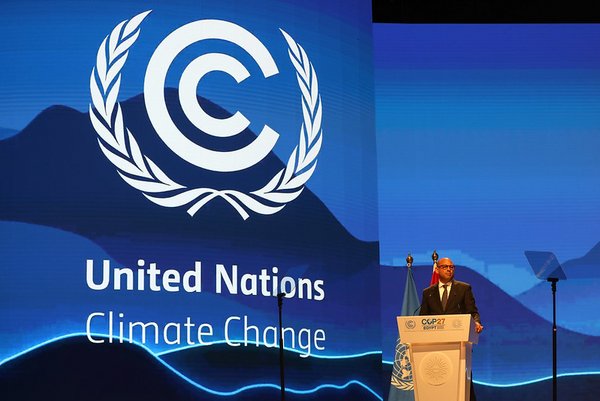 Read this article in French
Read this article in French- Share this article
- Subscribe to our newsletter
COP27: Breakthrough on loss and damage
The United Nations Climate Change Conference (COP27) in November 2022 brought together more than 45,000 participants to share ideas and solutions, and build partnerships and coalitions. The conference closed with an agreement to provide “loss and damage” funding for vulnerable countries hit hard by climate disasters.
“This outcome moves us forward,” said Simon Stiell, UN Climate Change Executive Secretary. “We have determined a way forward on a decades-long conversation on funding for loss and damage – deliberating over how we address the impacts on communities whose lives and livelihoods have been ruined by the very worst impacts of climate change.”
“On the issue of loss and damage, a breakthrough was achieved at this COP,” commented the German Foreign Minister Annalena Baerbock. “The international community agreed to establish joint financing mechanisms to help the people most affected by climate disasters.”
“We were able to ensure that this instrument targets the most vulnerable countries, and we at least started a process to explore new financing methods and take the major emitters to task – although many questions remain unresolved and controversial,” she added.
Fund for loss and damage
The package of decisions delivered by countries at COP27 reaffirmed their commitment to limit global temperature rise to 1.5 degrees Celsius above pre-industrial levels. It also strengthened action by countries to cut greenhouse gas emissions and adapt to the inevitable impacts of climate change, as well as boosting the support of finance, technology and capacity building needed by developing countries.
Creating a specific fund for loss and damage marked an important point of progress, with the issue added to the official agenda and adopted for the first time at COP27. Governments took the decision to establish new funding arrangements, as well as a dedicated fund, to assist developing countries in responding to loss and damage. Governments also agreed to establish a ‘transitional committee’ to make recommendations on how to operationalise both the new funding arrangements and the fund at COP28 next year. The first meeting of the transitional committee is expected to take place before the end of March 2023.
Parties also agreed on the institutional arrangements to operationalise the Santiago Network for Loss and Damage in order to catalyse technical assistance to developing countries that are particularly vulnerable to the adverse effects of climate change.
Progress on adaptation
COP27 saw significant progress on adaptation, with governments agreeing on the way forward for the Global Goal on Adaptation, which will conclude at COP28 and inform the first Global Stocktake, improving resilience among the most vulnerable. New pledges, totalling more than USD 230 million, were made to the Adaptation Fund at COP27. These pledges will help many more vulnerable communities adapt to climate change through concrete adaptation solutions. COP27 President Sameh Shoukry announced the Sharm el-Sheikh Adaptation Agenda, which will enhance resilience for people living in the most climate-vulnerable communities by 2030. In addition, UN Climate Change’s Standing Committee on Finance was requested to prepare a report on doubling adaptation finance for consideration at COP28 next year.
The conference’s cover decision, known as the Sharm el-Sheikh Implementation Plan, highlights that a global transformation to a low-carbon economy is expected to require investments of at least USD 4-6 trillion a year. Delivering such funding will require a swift and comprehensive transformation of the financial system and its structures and processes, engaging governments, central banks, commercial banks, institutional investors and other financial actors.
Serious concern was expressed that the goal of developed country Parties to jointly mobilise USD 100 billion per year by 2020 has not yet been met, with developed countries urged to meet the goal, and multilateral development banks and international financial institutions called on to mobilise climate finance.
At COP27, deliberations continued on setting a ‘new collective quantified goal on climate finance’ in 2024, taking into account the needs and priorities of developing countries.
(UNFCCC/ile)
More information:
Read more on the UNFCCC website
Decisions taken at the Sharm el-Sheikh Climate Change Conference
Sharm el-Sheikh Implementation Plan
German Foreign Minister Annalena Baerbock on the outcome of COP27





Add a comment
Comments :